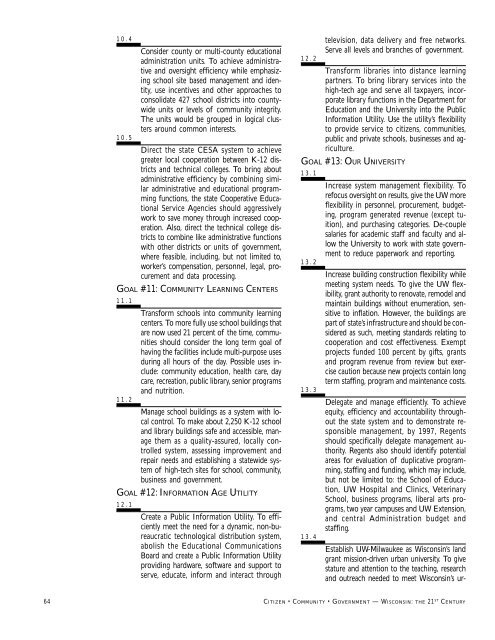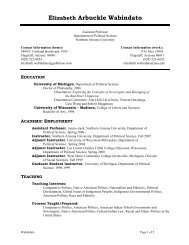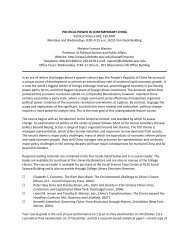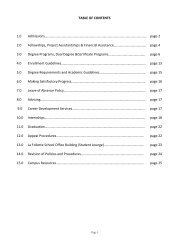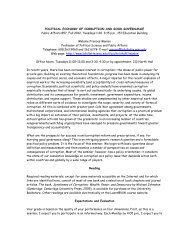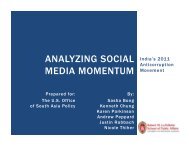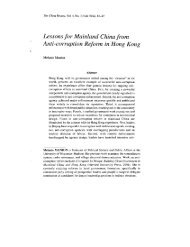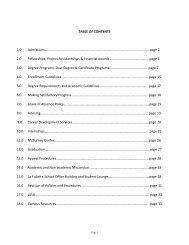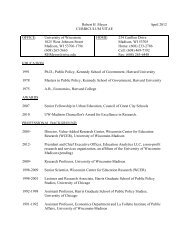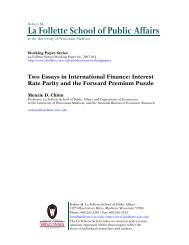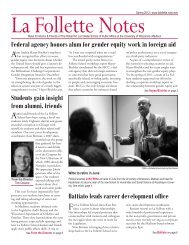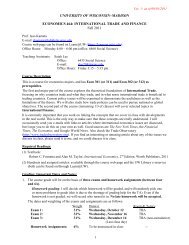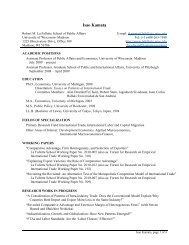SAVE Commission's findings - La Follette School of Public Affairs ...
SAVE Commission's findings - La Follette School of Public Affairs ...
SAVE Commission's findings - La Follette School of Public Affairs ...
You also want an ePaper? Increase the reach of your titles
YUMPU automatically turns print PDFs into web optimized ePapers that Google loves.
10.4<br />
10.5<br />
Consider county or multi-county educational<br />
administration units. To achieve administrative<br />
and oversight efficiency while emphasizing<br />
school site based management and identity,<br />
use incentives and other approaches to<br />
consolidate 427 school districts into countywide<br />
units or levels <strong>of</strong> community integrity.<br />
The units would be grouped in logical clusters<br />
around common interests.<br />
Direct the state CESA system to achieve<br />
greater local cooperation between K-12 districts<br />
and technical colleges. To bring about<br />
administrative efficiency by combining similar<br />
administrative and educational programming<br />
functions, the state Cooperative Educational<br />
Service Agencies should aggressively<br />
work to save money through increased cooperation.<br />
Also, direct the technical college districts<br />
to combine like administrative functions<br />
with other districts or units <strong>of</strong> government,<br />
where feasible, including, but not limited to,<br />
worker’s compensation, personnel, legal, procurement<br />
and data processing.<br />
GOAL #11: COMMUNITY LEARNING CENTERS<br />
11.1<br />
Transform schools into community learning<br />
centers. To more fully use school buildings that<br />
are now used 21 percent <strong>of</strong> the time, communities<br />
should consider the long term goal <strong>of</strong><br />
having the facilities include multi-purpose uses<br />
during all hours <strong>of</strong> the day. Possible uses include:<br />
community education, health care, day<br />
care, recreation, public library, senior programs<br />
and nutrition.<br />
11.2<br />
Manage school buildings as a system with local<br />
control. To make about 2,250 K-12 school<br />
and library buildings safe and accessible, manage<br />
them as a quality-assured, locally controlled<br />
system, assessing improvement and<br />
repair needs and establishing a statewide system<br />
<strong>of</strong> high-tech sites for school, community,<br />
business and government.<br />
GOAL #12: INFORMATION AGE UTILITY<br />
12.1<br />
Create a <strong>Public</strong> Information Utility. To efficiently<br />
meet the need for a dynamic, non-bureaucratic<br />
technological distribution system,<br />
abolish the Educational Communications<br />
Board and create a <strong>Public</strong> Information Utility<br />
providing hardware, s<strong>of</strong>tware and support to<br />
serve, educate, inform and interact through<br />
12.2<br />
television, data delivery and free networks.<br />
Serve all levels and branches <strong>of</strong> government.<br />
Transform libraries into distance learning<br />
partners. To bring library services into the<br />
high-tech age and serve all taxpayers, incorporate<br />
library functions in the Department for<br />
Education and the University into the <strong>Public</strong><br />
Information Utility. Use the utility’s flexibility<br />
to provide service to citizens, communities,<br />
public and private schools, businesses and agriculture.<br />
GOAL #13: OUR UNIVERSITY<br />
13.1<br />
Increase system management flexibility. To<br />
refocus oversight on results, give the UW more<br />
flexibility in personnel, procurement, budgeting,<br />
program generated revenue (except tuition),<br />
and purchasing categories. De-couple<br />
salaries for academic staff and faculty and allow<br />
the University to work with state government<br />
to reduce paperwork and reporting.<br />
13.2<br />
Increase building construction flexibility while<br />
meeting system needs. To give the UW flexibility,<br />
grant authority to renovate, remodel and<br />
maintain buildings without enumeration, sensitive<br />
to inflation. However, the buildings are<br />
part <strong>of</strong> state’s infrastructure and should be considered<br />
as such, meeting standards relating to<br />
cooperation and cost effectiveness. Exempt<br />
projects funded 100 percent by gifts, grants<br />
and program revenue from review but exercise<br />
caution because new projects contain long<br />
term staffing, program and maintenance costs.<br />
13.3<br />
Delegate and manage efficiently. To achieve<br />
equity, efficiency and accountability throughout<br />
the state system and to demonstrate responsible<br />
management, by 1997, Regents<br />
should specifically delegate management authority.<br />
Regents also should identify potential<br />
areas for evaluation <strong>of</strong> duplicative programming,<br />
staffing and funding, which may include,<br />
but not be limited to: the <strong>School</strong> <strong>of</strong> Education,<br />
UW Hospital and Clinics, Veterinary<br />
<strong>School</strong>, business programs, liberal arts programs,<br />
two year campuses and UW Extension,<br />
and central Administration budget and<br />
staffing.<br />
13.4<br />
Establish UW-Milwaukee as Wisconsin’s land<br />
grant mission-driven urban university. To give<br />
stature and attention to the teaching, research<br />
and outreach needed to meet Wisconsin’s ur-<br />
64 CITIZEN • COMMUNITY • GOVERNMENT — WISCONSIN: THE 21 ST CENTURY


